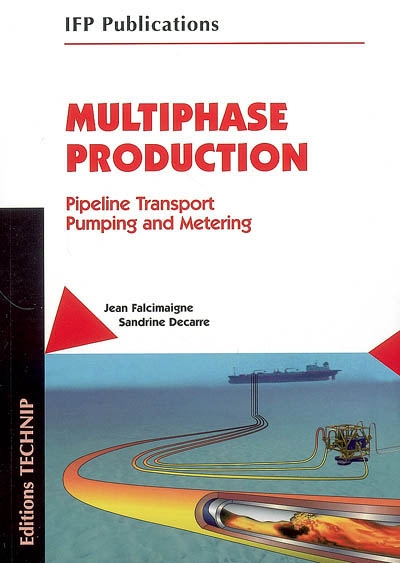Multiphase production
Pipeline Transport, Pumping and Metering
J. Falcimaigne/S. Decarre
Editions Technip
Foreword
V
Acknowledgements
VIII
Symbols
IX
Chapter 1
Multiphase flow in pipelines
1.1 Introduction
1
1.2 Flow Pattern Description
3
1.2.1 Gas-Liquid Flow4
1.2.2 Liquid-Liquid Flow5
1.2.3 Gas-Liquid-Liquid Flow7
1.2.4 Solid Suspensions8
1.2.5 Flow Pattern Transitions9
1.3 Physical Modelling
12
1.3.1 Basic State Equations12
1.3.2 Drift Flux Model14
1.3.3 Hydrodynamic Closure Laws for the Transportation Equations15
1.3.3.1 Stratified Flow15
1.3.3.2 Dispersed Flow17
1.3.3.3 Slug Flow18
1.3.4 Complex Phenomena20
1.3.4.1 Gravity Induced Slug20
1.3.4.2 Junction Flow21
1.3.5 Thermodynamic Modelling22
1.3.5.1 Fluid Behaviour22
1.3.5.2 Thermodynamic Models for Fluid Property Calculation24
1.3.5.3 Fluid Description30
1.3.5.4 Phase-Equilibrium Calculation33
1.3.5.5 Conclusion34
1.3.6 Thermal Aspects35
1.3.6.1 Introduction36
1.3.6.2 Fluid Heat Transfer Coefficient37
1.3.6.3 Surrounding Medium Behaviour38
1.3.6.4 Overall Heat Transfer Coefficient38
1.3.6.5 Conclusion41
Chapter 2
Multiphase Pumping
2.1 Introduction
43
2.2 Overview of Multiphase Pumping
44
2.2.1 Benefits and Typical Applications44
2.2.2 Types of Pumps44
2.2.3 Main Issues of Multiphase Boosting46
2.2.3.1 Variation of Flow Conditions46
2.2.3.2 Gas Compressibility49
2.2.3.3 Gas Re-Dissolution49
2.2.3.4 Reliability and Availability50
2.2.3.5 Sealing50
2.3 Positive Displacement Pumps
51
2.3.1 Twin-Screw Pumps51
2.3.1.1 Principle and General Arrangement51
2.3.1.2 Typical Duties, Performance55
2.3.1.3 Advantages, Limitations56
2.3.2 Progressing Cavity Pumps56
2.4 Helico-Axial Rotodynamic Pumps
57
2.4.1 Principle and General Arrangement58
2.4.2 Duties, Performance60
2.4.2.1 Head and Efficiency60
2.4.2.2 Multiphase Performance Multipliers61
2.4.2.3 Characteristic Curves63
2.4.2.4 Affinity Laws65
2.4.2.5 Multiphase Performance Models65
2.4.2.6 Flow Instabilities66
2.4.3 Advantages, Limitations66
2.5 Multiphase Pump Operation
67
2.5.1 Pump Duty67
2.5.1.1 Definition of Operating Domain67
2.5.1.2 Pump Selection Procedure68
2.5.2 Steady-State Performance Analysis68
2.5.2.1 Characteristic and System Curves68
2.5.2.2 Parallel and Series Operations70
2.5.3 Thermodynamic Topics70
2.5.3.1 Compression Work70
2.5.3.2 Temperature Rises72
2.5.3.3 Efficiency75
2.5.4 Transient Behaviour76
2.5.5 Pump Control77
2.5.5.1 Flow Homogeniser78
2.5.5.2 Self-Adaptability Capability78
2.5.5.3 Process Control78
2.5.6 Monitoring80
2.6 Field Applications of Helico-Axial Pumps
81
2.6.1 The Early Stage: Field Demonstrations81
2.6.2 Overview of Typical Surface Applications83
2.6.2.1 Samotlor - Western Siberia83
2.6.2.2 Duri - Indonesia83
2.6.2.3 Dunbar - Offshore North Sea84
2.6.2.4 Lennox - Offshore Irish Sea85
2.6.2.5 Priobskoye - Western Siberia86
2.6.3 Subsea Pumps Development and Applications86
2.6.3.1 Draugen - North Sea87
2.6.3.2 Topacio - Subsea Gulf of Guinea87
2.6.3.3 Ceiba - Subsea Gulf of Guinea88
2.6.4 Downhole Applications89
2.7 Conclusion
90
Chapter 3
Multiphase metering
3.1 Introduction
91
3.2 Fundamentals of Multiphase Metering
92
3.2.1 Mixture Composition92
3.2.2 Basic Measurements94
3.2.3 Velocity Slip Management and Flow Conditioning95
3.2.4 Types of Multiphase Meters96
3.2.5 Examples of Multiphase Meters97
3.3 Phase Fraction Measurements
97
3.3.1 Methods97
3.3.2 Gamma-Ray Densitometry99
3.3.2.1 Principles and Base of Technology99
3.3.2.2 Single Energy and Double Energy Densitometers101
3.3.2.3 Advantages and Drawbacks of Gamma-Ray Densitometers103
3.3.3 Electrical Methods103
3.3.3.1 General103
3.3.3.2 Conductance104
3.3.3.3 Capacitance and Microwave Methods104
3.3.4 Indirect Density Measurements108
3.3.4.1 Coriolis Meters108
3.3.4.2 Combination of Differential Pressure and Volumetric Flowrate108
3.3.4.3 Combination of Two Differential Pressure Measurements109
3.4 Flow Measurements
109
3.4.1 Methods109
3.4.2 Differential Pressure Measurements109
3.4.3 Volumetric Meters112
3.4.3.1 Positive-Displacement Meters112
3.4.3.2 Turbines113
3.4.4 Cross-Correlation113
3.4.5 Ultrasonic Measurements113
3.4.5.1 Acoustic Transducers114
3.4.5.2 Transit Time Measurements115
3.4.5.3 Acoustic Signal Backscatter116
3.5 Overview of Advanced Methods
117
3.5.1 Analysis of High Frequency Flow Signal117
3.5.2 Microwave Doppler Velocity Measurements118
3.6 Performance Description and Calibration
119
3.6.1 Operating Domain119
3.6.2 Performance Description120
3.6.2.1 Accuracy120
3.6.2.2 Repeatability121
3.6.2.3 Sensitivity and Tolerance121
3.6.3 Calibration121
3.6.4 Tests122
3.6.4.1 Factory Tests122
3.6.4.2 Tests in Multiphase Flow Facilities122
3.6.4.3 Field Tests124
3.7 Field Experience
124
3.7.1 Extensive Field Testing of MPFM124
3.7.1.1 Agar MPFM-400124
3.7.1.2 3-Phase Vx MPFM125
3.7.1.3 Roxar 1900VI128
3.7.1.4 Esmer MPFM128
3.7.2 Comparative Field Testing131
Chapter 4
New Challenges
4.1 Introduction
133
4.2 Hydrate Transportation in Slurry
133
4.2.1 Prevention of Hydrate Formation with Long Tie-Back133
4.2.1.1 Low Dosage Inhibitors135
4.2.1.2 Formation of Stable Non-Agglomerant Hydrates136
4.2.2 Main Issues of Slurry Transportation136
4.2.2.1 Behaviour of Hydrate Slurries136
4.2.2.2 Other Issues138
4.3 Subsea Separation
138
4.3.1 Experience of Subsea Separation138
4.3.1.1 Review of Past Attempts138
4.3.1.2 Gas Liquid Separation: the VASPS140
4.3.1.3 Produced Water Separation: the Troll Pilot Station140
4.3.2 Subsea Separation in Deep Water140
4.3.2.1 Introduction140
4.3.2.2 Advantages of Water Separation in Deep Water141
4.3.2.3 Advantages of Gas-Liquid Separation in Deep Water142
4.3.2.4 Main Issues of Subsea Separation142
4.3.2.5 DIPSIS: a Typical Water Separation Station144
4.3.3 Conclusion146
4.4 Subsea Gas Compression
147
4.4.1 Introduction147
4.4.2 Technological Concepts148
4.4.2.1 Compression Systems148
4.4.2.2 Direct Compression of Wet Gas148
4.4.2.3 Subsea Compression of Dry Gas150
4.4.3 Technical Issues of Subsea Compression150
4.4.3.1 Compressor Design150
4.4.3.2 Electrical Supply151
4.5 Multiphase Flow Turbines
151
4.5.1 Introduction151
4.5.2 Typical Applications of Multiphase Turbines151
4.5.2.1 General151
4.5.2.2 Upstream Applications152
4.5.2.3 Downstream Applications156
4.5.3 Technological Concepts157
4.5.3.1 Impulse Type TP Turbines157
4.5.3.2 Helico-Axial TP Turbine157
4.5.4 Main Issues157
4.5.4.1 Diversity of Turbine Characteristics159
4.5.4.2 Energy Recovery and Production Schemes159
References
161
Index
173

